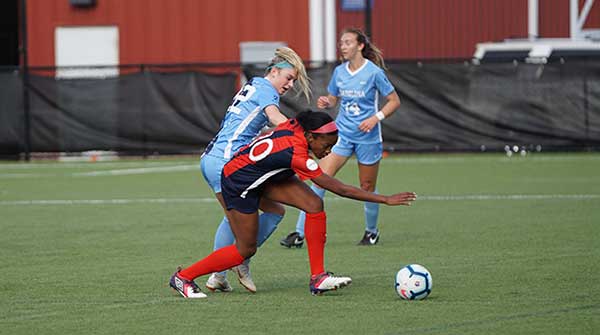Besides the physical fitness and social benefits of sport, recreational athletes use their sport participation as a way to cope with adverse life events, according to a University of Alberta study.
The study could help adult sport associations better market and reshape their leagues to combat shrinking participation rates.
“It’s not surprising that these recreational athletes relied upon their sport participation to adaptively cope with life adversity,” said Faculty of Kinesiology, Sport, and Recreation master’s graduate Kelsey Wright. “What was surprising was how similar the athletes’ stories were of relying on their sport, even though their adversities could be quite varied.”
When it comes to sports psychology, Wright – who worked in Amber Mosewich’s sport performance lab – said the research overwhelmingly looks at elite populations, so there’s a lot less support for lower levels of competition.
“In fact, there’s been so little research on those lower tiers of competition, I couldn’t find a unified definition of ‘recreational athlete,’” she said.
For the study, Wright interviewed 10 recreational athletes – six individuals who competed in group sports and four in individual sports. Soccer was played recreationally by three participants, making it the most common recreation sport.
Participants were asked to define “recreational athlete,” which was defined by their goals of “fun, fitness and social affiliation.”
They then talked about their past experiences with adversity. Here again, while adversity within sport is a focus for thousands of researchers, Wright said adversity away from the sport is not well studied at any level.
“Adversity is also a tricky definition because it’s self-defined. These athletes just self-defined as having experienced adversity,” she said. “The interesting part was, regardless of what the adversity was, the emotional response was pretty uniform.”
Her first finding was that the most common way recreational sport helped athletes cope with an adverse event in their life came courtesy of their renewed confidence if things went well.
Wright used an example of a recreational athlete having a relationship issue that was completely out of their control.
“If they then went to a rec hockey game and met their goal of scoring three goals or helping the team win, they felt they would be able to go out into their relationship problems with slightly more confidence,” she said. “It’s a confidence builder, but also a distraction.
“Social support within and outside of sport provided athletes with opportunities to resolve their emotions, while at other times sport distracted from negative emotions.”
Wright said distractions come up a lot in her research and coping literature in general, and they’re not always good.
“If we see a behaviour as distracting from resolving an adverse event, it could be something that distracts us from making adaptive progress,” she said. “But if the adverse event doesn’t have any solutions, like grief, or if you’ve lost something you can’t get back, then a distraction is really positive in that circumstance.”
Another finding was linked to the unique social support built within sport, whether a team or individual sport.
Wright said all 10 athletes spoke about relying on those social networks to give them advice and provide them with emotional coping responses.
“Some people said the support came from bonds they’ve had with teammates for years, while others said they relied on the objectivity that people outside of their usual social sphere were able to give them,” she said.
Wright noted that all of these recreational sport coping mechanisms were contingent on a psychological safety component triggered by the athletes’ level of competition.
“If the level of play didn’t match their goals – if the sport was too easy or too hard – then they didn’t feel safe in that environment and didn’t find it to be effective for their coping,” she said.
Wright said this kind of research is becoming more pressing as adult participation in sport has dropped by nearly 20 per cent over the past two decades in Canada and is especially glaring in the 18-to-29 age category.
She suggested reframing some of the marketing tactics to include these coping effects to further curtail that downward trend. She added this research supports the case for providing more tiers of competition within recreation to better accommodate the goals of each athlete.
“Greater investment in their athletic identities provided more sport coping opportunities, bettering recreational athletes’ responses to adversity.”
| By Michael Brown
Michael is a reporter with the University of Alberta’s Folio online magazine. The University of Alberta is a Troy Media Editorial Content Provider Partner.
The opinions expressed by our columnists and contributors are theirs alone and do not inherently or expressly reflect the views of our publication.
© Troy Media
Troy Media is an editorial content provider to media outlets and its own hosted community news outlets across Canada.



